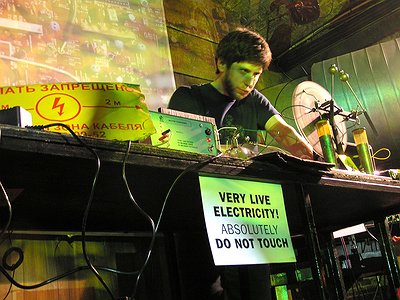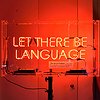Part 2
Listening can be both a solitary and a communal activity. Likewise, creating music can be private or collaborative. Can you talk about your preferences in this regard and how these constellations influence creative results?
To be honest I’ve heard performers in electronic music say, quite often, that because what they do is, in their opinion, “art”, therefore, because of that, the audience is completely irrelevant to them. A bit like becoming part of a tradition whether you like it or not, similarly all performers and artists are entertainers, whether they’re aware of that, whether they acknowledge that, and whether they like it or not. So, while I appreciate the work Disinformation makes isn’t for everyone, Disinformation products are still entertainment - highly specialised and niche, but still entertainment.
The relationship with the audience is critical, and some Disinformation projects, particularly a sound and light installation called “The Origin of Painting”, are highly interactive and participatory, and highly communal.
Many Disinformation projects have been collaborative, including videos made with the film-maker Barry Hale, but I’m not much of a one for directly participating in muso-collabs… I’m more of an engineer, not really a musician.
There are remixes of Disinformation tracks, and collaborative versions of “National Grid”, performed with Evan Parker, Test Department, Mike Walter and Andy Knight, Paul Nomex, Eleanor Westbrook, Ilia Rogatchevski etc, though basically these have been cases of light the blue touch paper and stand back while the real musicians get on with the work.
How do your work and your creativity relate to the world and what is the role of music in society?
I guess what I said just now is a way of saying that art is all about communication, though the general question about how art and music relate to society depends on the specifics of what you say and do, case-by-case, so the broader question is hard to answer, in general terms.
In 2015 I wrote down a series of short axioms for a booklet produced by Nick Thurston at the University of Leeds. The axioms include the statement that “the medium is not the message”, which is also used in the “Language [as] Meta-Technology” sound artworks in 2018 and 2021. I didn’t say “the medium is not the message” because I don’t understand what Marshall McLuhan meant when he originally said “the medium is the message”, I was hoping to re-focus attention onto the content of what’s being said.
You hear a great deal in alternative culture circles about the so-called “limits” of language, which can be frustrating, because this can, at worst, be used as a kind of rhetorical device, to, more-or-less cynically, create an empty space onto which artists project an illusion of profundity in relation to work that sometimes frankly lacks content. We have more to gain I think from exploring the possibilities of language.
Art can be a way of dealing with the big topics in life: life, loss, death, love, pain, and many more. In which way and on which occasions has music - both your own or that of others - contributed to your understanding of these questions?
As discussed, the Disinformation project was not originally intended to provide a platform for self-expression, but it soon became clear that all editorial choices reflect the experiences of the person that makes them. So, you end up expressing yourself whether you like it or not. As for life and loss, love and death etc, I’ve gone from trying, at least superficially, to appear quite neutral in relation to self-expression, to, more recently, basically giving up the ghost and diving right in. “The Rapture” installation - showing at Cable Depot in Woolwich in June and July 2022 - is intensely personal, and deals with everything you talk about here.
In terms of what you mention, I don’t want to talk about this in detail, but I’ve literally seen the light at the end of the tunnel… luckily I was able to make a decision to turn back.
As for how much music contributes to understanding the big human questions, to be honest, on reflection, I’d say not so much?
Music is a great communicator and amplifier of emotions, but, as for profound understanding, this usually comes from discussion and from reflection rather than from music, I think. This has something to do with the emphasis on language in more recent projects, like “The Act of Creation”, aka “Let There Be Language”, and “Language [as] Meta-Technology” etc - superficially the style is “technical” and neutral though in fact they’re based on years of experience and reflection.
There seems to be increasing interest in a functional, “rational” and scientific approach to music. How do you see the connection between music and science and what can these two fields reveal about each other?
Chris Sharp once wrote in The Wire magazine that “music, for all its ineffability, is at best just a specialised branch of physics”, and I agree, though I’m also a fan of the view expressed by Martin Esslin in his book The Theatre of the Absurd, where he states that there’s little contradiction between the use of art to explore the ineffable, and a rationalist and scientific world-view, not least because so little of what we experience is amenable to rational explanation in the first place.
The dialogue in the “Language [as] Meta-Technology” sound artwork asserts that “art is not necessarily science, but science is always art”, and I guess that’s a bit of an exaggeration, however the point is that there’s an aspect of creativity and beauty in all forms of science, which passes a test for being considered art, though not necessarily very good art, while the equivalent probably can’t be said about many forms of art.
Creativity can reach many different corners of our lives. Do you feel as though writing or performing a piece of music is inherently different from something like making a great cup of coffee?
What do you express through music that you couldn’t or wouldn’t in more “mundane” tasks?
An argument put forward in the Rorschach Audio book is that all perception is in itself inherently creative, and this is argued and demonstrated in the book with a great deal of direct evidence. So, there’s an element of “art” in something as fundamental as the way we form basic perceptions - see images, hear sounds etc. On that basis, “art” includes the actions of absolutely everyone, albeit to varying extents, and the difference between “minor” and “great” art is just a matter of degree (though that difference is by no means trivial). So, yes, notwithstanding some obvious mechanical differences, making great food can definitely be compared to writing great music.
As it goes my grandma was a cookery writer, and at her memorial service her friend Paul gave a eulogy which said that the real meaning of the word “culture” is to grow plants, for consumption, the implication being that the creative arts either are, or at least can be thought of as being, a sub-set of what might be called cuisine. I’m not sure that’s definitely accurate, but, in terms of reversing or inverting a conventional perspective, it’s certainly thought-provoking.
Music is vibration in the air, captured by our ear drums. From your perspective as a creator and listener, do you have an explanation of how it’s able to transmit such diverse and potentially deep messages?
As you say, vibration has a great deal to do with this, in the sense that our understanding of the term “deep” ultimately comes from experiences of vibrations that travel through the ground. Some of the work I like to create is essentially music pushed to an extreme, where music becomes a form of kinetic art. This is an important aspect of “National Grid”. Also, more recently, I used the audio from “The Analysis of Beauty” exhibit to drive an installation called “Closed Circuit”, which was organised by the curatorial partnership Matchett & Page, and exhibited in July 2021 by Drawing Matter in Somerset. Basically, you walk inside a massive steel grain silo, and, when you feel the metal physically vibrating, you realise that the sound that’s rippling around the space isn’t coming from a loudspeaker, it’s coming from the walls of the actual building.
In a sense it’s trying to share experiences of this kind of weapons-grade vibration that I had with dub reggae in the early 80s, and with acid house in the late 80s - very intense but relaxing and exciting. In the more general sense, just trying to find materials and symbols which actually represent the kinds of experiences people actually have in the contemporary world. The symbolic language of mainstream visual art is in many respects decades behind the avant-garde of popular culture.






